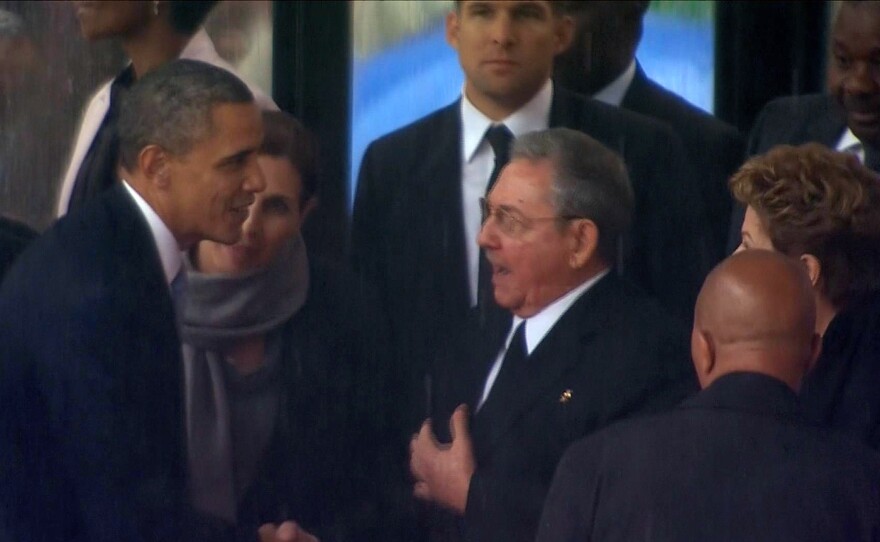
Just months after he seized power in Cuba, Fidel Castro visited Washington in April 1959. He placed a wreath at the base of both the Lincoln and Jefferson memorials and was photographed looking up in seeming admiration of both U.S. presidents.
For U.S.-Cuba relations, it was all downhill after that.
It's been a stalemate that has outlasted 10 U.S. presidents, a failed invasion, a nuclear crisis and countless boatloads of Cuban asylum seekers. Meanwhile, the Castro brothers have kept running Cuba for more than a half-century.
President Obama, the 11th president to deal with the Castros, said Wednesday it's time for a change.
"We cannot keep doing the same thing and expect a different result," the president said as he announced plans to normalize relations, including embassies in both capitals.
The U.S. Embargo
With Castro's rise, attempts to establish normal relations soon gave way to mutual recriminations. The young Cuban leader denounced "Yankee imperialism" and developed ties with the Soviet Union. President Eisenhower placed an economic embargo on Cuba in October 1960 and diplomatic relations were severed the following year. The Cold War moves were intended to contain, if not roll back communism, but it soon seemed the measures would be overtaken by far more dramatic events.
The U.S.-backed Bay of Pigs invasion, a 1961 disaster carried out by Cuban exiles, was just one of at least eight futile U.S. attempts to oust Castro in the 1960s. The Bay of Pigs was followed a year later by the Cuban Missile Crisis, the U.S.-Soviet staredown that ended with Moscow removing its missiles from the island.
Lesser crises came and went in the years that followed, but the embargo always endured. It has succeeded in keeping Cuba poor and isolated, but has also served as a badge of defiance for the Castros who have blamed their own shortcomings on the U.S. policy.
Despite the embargo, the Castro regime has never been seriously threatened from inside Cuba and over time the U.S. policy developed its own contradictions.
The older generation of Cuban-Americans who fled during the early years of Fidel Castro's authoritarian regime has been the strongest proponent of maintaining the tough embargo.
Yet over time, growing numbers of this generation have conceded that the policy was not working. Cuban-Americans have also been the most frequent visitors to Cuba, often delivering assistance to relatives on the island and thus helping ordinary Cubans cope with the hardships of the embargo.
Meanwhile, a younger generation of Cuban-Americans born in the U.S. have shown far less interest in waging the battle launched by their parents.
For Decades, Few Changes
Prior to Obama's announcement on Wednesday, alterations to the status quo were marked by limited steps. Under President Carter, the countries opened interests sections in each other's capitals.
Carter also said those wishing to leave Cuba would be welcome in the U.S. Some 125,000 Cubans set off from the island, most all in small boats in the so-called Mariel boatlift. The new arrivals included many thousands that Castro cut loose from the country's prisons and mental institutions.
Many Americans felt Castro had pulled a fast one on the U.S., and the embargo was tightened with a series of measures in the 1980s and 90s. The pendulum swung the other way in 1999, when President Clinton eased travel restrictions and encouraged increased cultural exchanges.
Under President George W. Bush, U.S. relations with Havana deteriorated as the president declared: "We're not waiting for the day of Cuban freedom; we are working for the day of freedom in Cuba."
However, the U.S. embargo has faced increasing criticism from the international community, particularly in Latin America, where many countries feel that Washington's isolation of Cuba has increasing proved counterproductive.
There were hints that the U.S. policy might change, but little concrete action, after Raul Castro assumed the presidential duties from his ailing brother in 2006 and Obama expressed his preference for increased ties. Raul Castro has taken some steps to allow small-scale private businesses. though the reforms have moved slowly.
Just a year ago, it caused a diplomatic stir when Obama shook hands with Raul Castro at a memorial service in South Africa following the death of Nelson Mandela. It was described as only the second handshake between leaders of the two countries in the past half-century and observers tried to divine if it held any meaning for the future of U.S.-Cuban relations.
"Mandela showed us the power of action," Obama said in his speech, "of taking risks on behalf of our ideals."
Copyright 2014 NPR. To see more, visit http://www.npr.org/.






